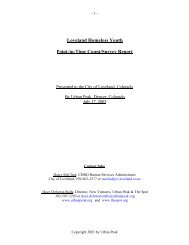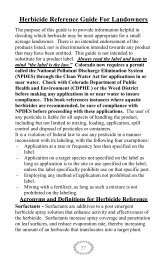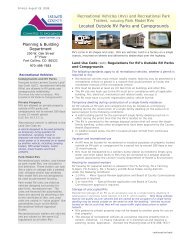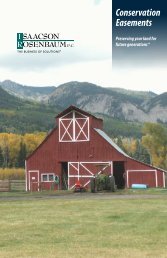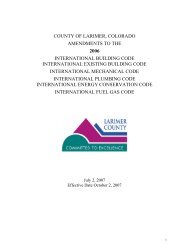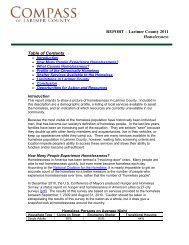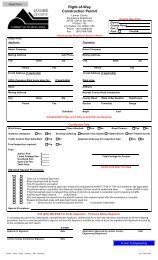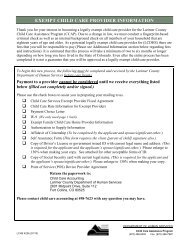LARIMER COUNTY RURAL AREA ROAD STANDARDS
LARIMER COUNTY RURAL AREA ROAD STANDARDS
LARIMER COUNTY RURAL AREA ROAD STANDARDS
Create successful ePaper yourself
Turn your PDF publications into a flip-book with our unique Google optimized e-Paper software.
Appendix G – Design and Construction Standards for Private Local Access RoadsSection G.7 Road Design StandardsG.7.2 Road GradeRoad design must incorporate a maximum longitudinal slope of 8% (10% inmountainous terrain). Road designs exceeding these longitudinal slopes must ensurethat other safety and site disturbance guidelines are not compromised. Wheretopography requires, steeper grades may be necessary. The Engineer may grantdeviations in writing for unusual cases in mountainous or hilly terrain. However, theaverage grade for 200 feet should not exceed 12%.G.7.3 Horizontal Road CurveRadii of curvature on centerlines may be a minimum of 100 feet (60 feet in steep terrain),so long as adequate sight distance exists to allow a safe stopping distance.Mountainous terrain may require a deviation from this standard if topography is steep.The Engineer must approve such variance.G.7.4 Vertical Road CurveFor safety reasons, design of crest vertical curves (top of hill crests) must be based onthe design speed of the road. The design speed must take into account sight distancelimitations which result from extreme crest vertical curves. Correspondingly, sag verticalcurves (bottom of hill) must also be designed based on the design speed, such thatheadlight visibility will not be compromised in nighttime or dim light conditions.Recommended design speed for most local access roads is 15 mph in steep,mountainous areas and 25 mph in rolling to flat areas.G.7.5 Road IntersectionsIntersections should be within ten degrees of perpendicular for at least 50 feet fromintersection centerlines with adequate sight distance both directions. If topographyallows, grades should flatten to 3% or less for at least 50 feet approaching intersections.G.7.6 Dead End RoadsDead end multiple access roads must be constructed with a vehicular turnaround area atthe end or within the last 600 feet of roadway. Single access roads exceeding 600 feetin length should incorporate this standard as well. Turnarounds may take a number offorms (Figure 2), including a traditional cul-de-sac bubble, a hammerhead or “T” shape,or a turning loop. Cul-de-sac bubbles and turning loops must have a minimum radius of40 feet. T’s must have a minimum length of 35 feet on both sides. For roads narrowerthan 20 feet, turnouts must be provided at approximately every 600 feet of road. Greaterdistances may be allowable if good sight distance is maintained between adjacentturnouts. The turnouts must be constructed to allow turning movements to be made byemergency vehicles (Figure 2). Turnouts must be an all weather road surface at least 8feet wide and 30 feet long.Note: Though not a requirement in the design for 20 ft wide roads, turnouts should beconsidered if the road is the single access and egress point to the parcels served.G.7.7 Cuts and FillsRoadways should follow existing contours to the extent possible. Roadway cuts andembankments should be considered only to the extent they are necessary to maintainLarimer County Rural Area Road Standards Page G-5October 22, 2007



